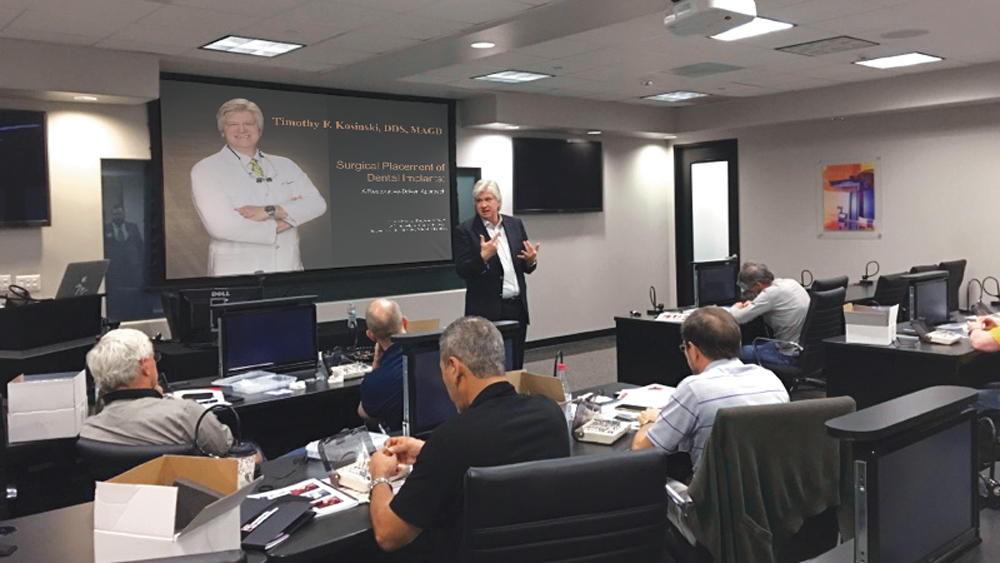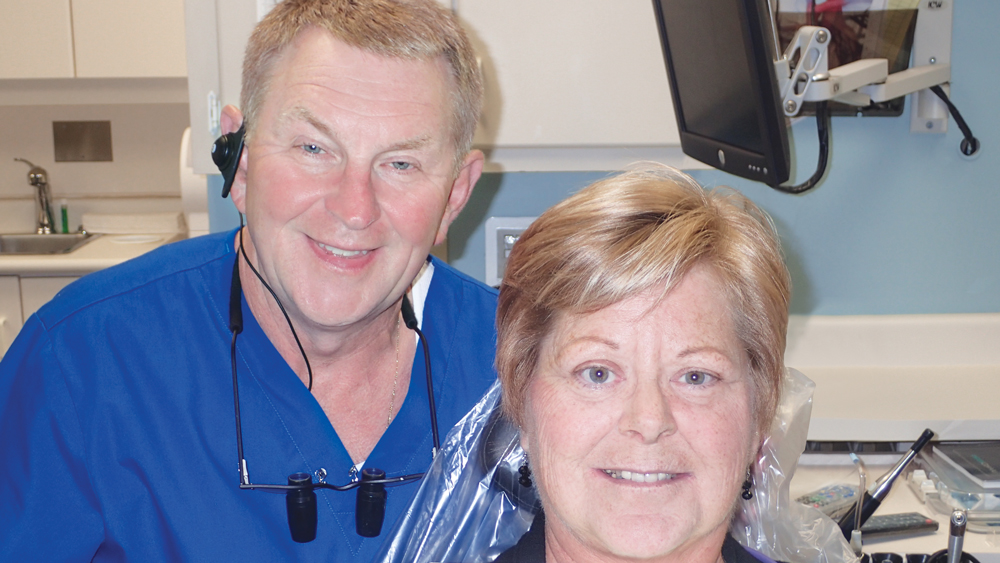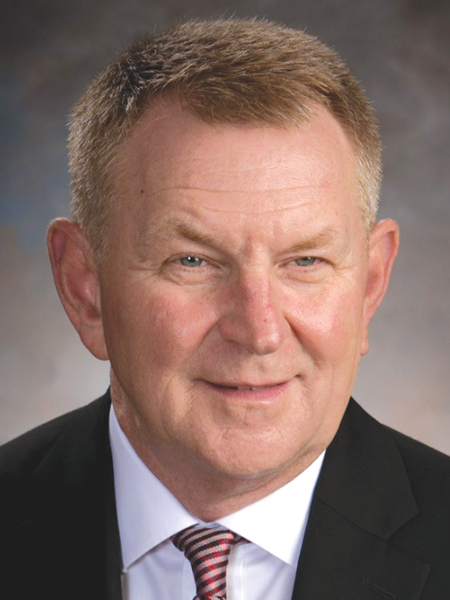My First Glidewell HT™ Implant with Mark J. Connelly, DDS

Note: The Hahn Tapered Implant System is now known as the Glidewell HT Implant System
Dr. Mark Connelly is a general dentist in St. Johns, Michigan, who recently upgraded his implant skills by attending a course taught by Dr. Timothy Kosinski. Here, he explains his motivation for expanding the implant services he offers patients, why he chose to adopt a new implant system, and the success he’s had incorporating new surgical techniques like extraction with immediate implant placement into his practice.
Chairside® magazine: What initially got you interested in placing dental implants?
Dr. Mark Connelly: I wanted to expand into new areas of dentistry and offer my patients a full-service general dental practice. I saw the need for implants, and patients were asking about them and wanting to have them done. Also, I’ve always been interested in and enjoyed doing oral surgery.
CM: After learning to place implants, did it seem like patients were more interested in receiving treatment if it came directly from you instead of being referred out to a specialist?
MC: I think there are three big barriers to having patients accept dental implant treatment. One is that when they get referred out from a general dentist, patients don’t always follow through and see the specialist. So the more the general dentist can do for the patient, the better. The second part is the cost factor. They always think, “Oh my gosh, if I go to the specialist it’s going to be so much more,” and it usually is. And third, there’s the problem of communicating the proper implant position to the specialist. As a general dentist, I know how I want to restore it, but it can be difficult to stay on the same page when the case is referred out. When I can both place the implant and restore it for the patient, it makes it easier to execute a restorative-driven treatment plan.
Patients don’t always follow through and see the specialist. So the more the general dentist can do for the patient, the better.
CM: How long ago did you first begin placing implants, and what training did you receive prior to your first case?
MC: Probably about 10 years ago. I took some courses with the Academy of General Dentistry. That’s where I first met Dr. Timothy Kosinski. They would have hands-on courses with models, where you’d learn the theory behind implant therapy, the basic anatomical considerations, and the science behind it all. Then I took a course in New York where I learned some IV sedation training and was able to place some implants with the oral surgeons standing behind me and helping out, which was an experience that gave me a lot of confidence.
CM: And you recently took another course with Dr. Kosinski, correct?
MC: Yes, it was a course on restorative-driven implant treatment at the Glidewell International Technology Center.
CM: Prior to taking Dr. Kosinski’s course with Glidewell, how many implants were you placing a week, and what types of cases were you primarily working with?
MC: I was placing about 15 to 20 implants a year, so I really wasn’t doing very many — one or two a month at the most. These were mostly cases like a first molar with a large distance from the mandibular canal, or a bicuspid. I had done some anterior implants with sufficient bone and thick gingiva, where there wasn’t a high esthetic demand, as well as some lower overdentures. I would end up referring the other cases, like those in the esthetic zone, requiring a sinus lift or needing other advanced forms of grafting.
CM: What motivated you to take Dr. Kosinski’s course and upgrade your surgical skills?
MC: I’ve been in dentistry for over 30 years and implants have always fascinated me, but I was starting to get a little bored with things and wanted to expand the services I offer my patients. I had been consulting with Dr. Kosinski, who I’ve known for many years, on some cases I had been planning. When I told him I was interested in giving the Hahn™ Tapered Implant (Glidewell Direct; Irvine, Calif.) a try, he said it would be a great idea to take his course because a Hahn surgical kit and implants were included in the tuition cost. I had been wanting to learn some more advanced indications, so it was the perfect opportunity.

Immediate implant placement is one of several techniques Dr. Mark Connelly learned at a recent course taught by Dr. Timothy Kosinski, shown here teaching a class at the Glidewell International Technology Center in Irvine, California.
CM: What made you interested in the Hahn Tapered Implant System?
MC: The price is certainly right, and I’ve been using Glidewell for some time for restoring my implants. When I was at the Chicago Dental Society Midwinter Meeting earlier this year, where they do a really nice job with the booths and these little table clinics, I ran into Dr. Jack Hahn, who developed the Replace Select™ implant for Nobel Biocare and of course created the Hahn Tapered Implant System. I went over there and picked his brain. He told me all about how he developed the Hahn implant, how he created the new thread design, what Dr. Carl Misch had said about it, and how it’s the official implant of the Misch International Implant Institute. It was a nice opportunity to get some information from the actual developer of the implant.
CM: Can you talk about your recent experience taking Dr. Kosinki’s course and what you learned?
MC: One of the things with Dr. Kosinski is that he shows hundreds of slides of his cases to illustrate the principles he’s teaching. That repetitive exposure to different cases really hammered home the three basic indications that I’ve brought back to my office from his recent course. First, there’s extraction with immediate implant placement, and I’ve already done a few of those. Then there’s the flapless approach, where you just use a tissue punch and create the osteotomy directly through that opening; I’ve done three of those since I’ve been back. And then there’s bone grafting. I’ve been using Newport Biologics™ Mineralized Cortico/Cancellous Allograft Blend (Glidewell Direct) and resorbable collagen membranes after performing extractions in order to preserve bone for implant placement. And of course, I’ve also been adding some grafting material for the immediate implants I’ve placed.
CM: After using the Hahn Tapered Implant System at Dr. Kosinski’s course during the hands-on exercises, what were your initial thoughts?
MC: I found that it’s an easy-to-use system, and I like the depth-specific drills. I certainly like the amount of initial stability I can get when I place those. And it’s really helped bring down the cost of treatment and make it affordable for my patients. I started with the Replace Select system many years ago, but the implants were very expensive, and I believe cost is a huge barrier to patients receiving dental implants. With the Hahn system, I’m getting a great implant at a great price, and when I prescribe restorations over Hahn implants, I get a 20 percent discount from Glidewell Laboratories. The mission of Glidewell to make implant dentistry more affordable works well for my patients and me.
I certainly like the amount of initial stability I can get when I place [the Hahn Tapered Implant]. And it’s really helped bring down the cost of treatment and make it affordable for my patients.
CM: Can you tell us about the first Hahn Tapered Implant you placed after completing Dr. Kosinski’s course?
MC: Sure. This happened to be my sister, who lives a couple hours away, and she thought her crown had just come off — and this is a common case that happens in dental practices. She thought she was just going to be able to come in and get it cemented on. But in actuality, the PFM crown had broken off her tooth at the gum line. There was adequate thickness of bone buccolingually. I took X-rays, and there was adequate depth apical to the tooth. I was able to extract the tooth and immediately place the implant in the same appointment. This was ideal for my sister, because she lives two hours away and finds it difficult to make it to my office.
CM: What did you learn from that first experience?
MC: One of the key takeaways from attending Dr. Kosinski’s course and performing my first immediate implant placement procedure is that you have to deliberately stay toward the palatal of the extraction socket. Some people may think that you just place the implant directly in the path of the socket site, but then the angulation is all wrong and you risk fracturing the buccal plate. So you really have to be conscious and aware of that and prepare the osteotomy toward the palatal. And the thread design of the Hahn implant really helps you keep that position because it goes right where you direct it during placement, at a safe distance from the buccal plate. It’s almost like a self-tapping screw.
CM: How did you feel before completing that first immediate placement procedure? Were you apprehensive?
MC: I was pretty excited because I felt like I was prepared to do it properly from taking the course. Prior to that course, I would have taken the tooth out, waited at least three months for the bone to heal, and then placed the implant. Learning this procedure really enabled me to reduce the number of appointments and speed up the time it took to get my sister her restoration. It was a relatively atraumatic procedure; she only had to take a few ibuprofen for any discomfort she had. Also, because I was able to get great initial stability, I put in a Hahn healing abutment and didn’t even have to do a second surgery to expose the implant for restoration.
Learning this procedure really enabled me to reduce the number of appointments and speed up the time it took to get my sister her restoration.
CM: So it sounds like the surgical procedure went just as you expected.
MC: Oh, it was a slam dunk. And my sister was very happy about it. A lot of people are disappointed when you tell them, “We’ll take this tooth out, wait three or four months, and then we’ll place the implant.” Since I learned to do immediate implant placement at Dr. Kosinski’s course, the patients for whom the procedure was indicated have just been thrilled. They say, “Oh, you can do it right now?” And I say, “Yeah!” It’s very appealing to patients.
CM: How have the other types of implant procedures you learned at Dr. Kosinski’s course gone?
MC: The flapless procedure has been huge. With an implant in the area of a missing tooth, instead of making incisions and flapping the soft tissue, I can take a tissue punch, make a hole where I want the crown to emerge from the soft tissue, complete my osteotomy through that little opening, and place an implant and healing abutment. That’s one of the nice things about the Hahn implant — I get the initial stability I need to put in a healing abutment. Then the patient is on his or her way, and there’s very minimal discomfort.

Dr. Connelly after completing his first extraction with immediate implant placement case. The patient, his sister, was very happy with the efficiency of the procedure, which reduced the total number of appointments and the overall treatment time.
CM: How have learning these new surgical procedures and adopting the Hahn Tapered Implant affected your practice?
MC: It’s gotten me more excited about being a dentist at this stage in my professional career. I’ve gotten the hands-on training I need to expand my implant services, and I’m much more confident. I’ve started treatment planning more cases and placing implants more frequently, including a lot of situations I used to refer out, which my patients like.
CM: Would you recommend that other GPs placing implants take an intermediate course to firm up their implant skills and explore additional indications?
MC: Based on my own experience, implant dentistry is not something you take lightly. It’s not something where you can just take a weekend course or one class. It’s a commitment to continual learning and expanding your knowledge and skill level. I would highly recommend the course I took with Dr. Kosinski, especially when he does it out at the Glidewell International Technology Center in California — just to see the facility there is something else.
CM: What advice would you offer to general dentists who are thinking about getting started with the surgical aspect of implant treatment?
MC: If you’re going to be practicing dentistry, I think it’s important to understand the surgical aspect because it’ll help you be a better restorative dentist. The patients are going to be more likely to accept implant treatment if it’s being offered within your practice, so it’s going to be a valuable service to offer. Even if they don’t want to do the surgery, I would definitely advise that dentists become more educated about the surgical aspect of dental implants so that they’re more knowledgeable when they talk to patients about it.



